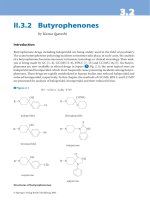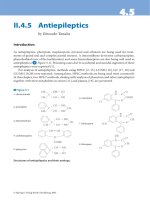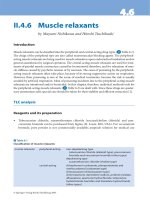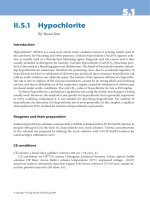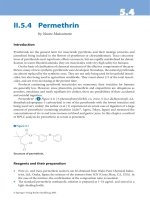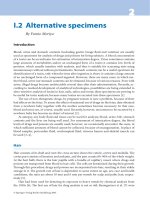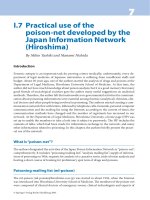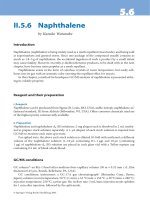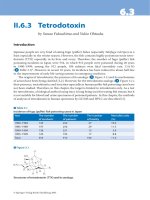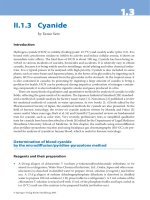Energy Storage in the Emerging Era of Smart Grids Part 12 pptx
Bạn đang xem bản rút gọn của tài liệu. Xem và tải ngay bản đầy đủ của tài liệu tại đây (2.67 MB, 30 trang )
Renewable and Sustainable Energy Reviews
The Times [online].
Proceedings of CIGRE Symposium Power Systems with Dispersed Generation
British Broadcasting Corporation [BBC].
IEEE Power and Energy Society General Meeting
IEE Proceedings Generation, Transmission and
Distribution,
Proceedings of CIRED 2007 19th International
Doctorate thesis
44th International Universities Power
Engineering Conference, (UPEC 2009)
North American Power Symposium
2nd European Conference SmartGrids and E-
Mobility
International Conference on Future Power
Systems
IET-CIRED
Seminar
proceedings of the 23rd
Conf. on Energy, Economy, and, Environment
Power Systems, IEEE Transactions
IEEE Power Tech
IEE Vehicle Power and Propulsion Conference (VPPC)
45th International Universities Power Engineering Conference (UPEC),
Conference on Electric Utility
Deregulation and Restructuring and Power Technologies (DRPT)
IEEE Power Engineering Society Conference and Exposition in
Africa, 2007. PowerAfrica
15
Sizing and Management of Energy Storage
for a 100% Renewable Supply
in Large Electric Systems
Oscar Alonso, Santiago Galbete and Miriam Sotés
Acciona,
Spain
1. Introduction
Many developed countries are moving towards a low carbon economy and are therefore
demanding higher levels of renewable energy sources. These energy sources include wind,
solar, biomass, etc. to supply the energy demand. Nevertheless, there are still some aspects
that warrant further technical and economical feasibility studies for those renewable energy
sources to be considered sustainable alternatives.
The random nature of renewable energy sources, mainly solar and wind is the major
limiting factor in achieving significant penetration in any electric system. This limiting
factor has different consequences depending on the ratio between the amount of
renewable generation and the demand level. This has been studied by many authors from
different perspectives and in many cases the key element was energy storage. For
example, energy storage can be used to reduce the production fluctuations of large scale
wind farms, to move a certain production amount to better remunerated periods, to
reduce prediction errors to minimize penalties, to increase the power predictability, to
participate in secondary power markets and to achieve fully controllable energy
production through any renewable primary source. In such way, any renewable generator
would offer guaranteed production and may participate in electric markets on equal
terms with non-renewable generators.
Most analyses of isolated large electric systems with renewable supply and storage are
performed based on energy balance results over several years (Bremen et al., 2009)
(Alonso et al., 2009, 2010). This methodology has been extended in order to include real
data measurements from various renewable technologies and also storages with different
dynamic and rates. In particular, this method allows the resolution of multiple scenarios
of renewable penetration levels, profiles, technologies, etc in order to obtain the minimum
storage service that will reduce the conventional production or even satisfy a total supply
of the demand through only renewable producers. This methodology has been firstly
used to analyse a suitable large system: the Spanish electric system. Although Spain is
electrically connected with other countries, the low rates in exchanged energy allow the
simplification to consider it as an isolated system. As it will be shown, Spain offers
excellent opportunities to produce large amounts of renewable production. However, the
Energy Storage in the Emerging Era of Smart Grids
322
integration will require some storage to guarantee the electrical supply meets the demand,
especially in future scenarios where 100% is proposed only using renewable sources.
Nevertheless, the existence of current hydro systems with huge storages strongly reduce
the need of additional units.
The transition from current generating mix (renewable and non-renewable) to a likely future
generation mix (with only renewable) has been also analyzed. As it will be explained, the
prompt introduction of these storage systems, better if it is arranged in a very disperse way,
will ease the replacement of conventional generation, starting with those units especially
pollutant. Finally, some proposals of future scenarios are also presented and discussed
regarding technical feasibility.
2. Random nature of renewable energy sources
Renewable energy from wind and solar sources are rapidly increasing their influence in the
electric grid system worldwide. Both energy sources are uncontrollable by nature. Because
of that when their contributions become important, locally and at greater scales, several and
well reported grid integration problems may arise. Although energy demand and renewable
production are random in nature, demand usually maintains a clear tendency that allows its
reliable forecasting, especially in developed countries. For example, figure 1 shows the
typical demand profile during a working and a non working day for Spain during 2010.
Demand follows a similar profile experiencing variations during the year; season
dependent, and also from one year to another, figure 2. These variations normally depend
on the economical situation and the development level of the analyzed system. For example,
2006 Spanish electric demand versus 2005 verified an increase around 2.9%, while 2006
versus 2007 was about 3.8% (REE, 2009).
Fig. 1. Example of daily electric demand in Spain (Working and non working day)
Sizing and Management of Energy Atorage for a
100% Renewable Supply in Large Electric Systems
323
Fig. 2. Monthly demand in Spain (2005 – 2007)
In a preliminary stage the following basic balance is valid for any isolated electric system
without storage.
Non Renewable Power Potential Renewable Power
Power Demand System Power Losses Renewable Power Losses
+
=
++
(1)
In this equation, Non Renewable Power represents all power contributions coming from
conventional energy sources such as coal, gas, nuclear, co-generation, etc –based power
plants. Potential Renewable Power is the power that could be produced at any moment taking
into account all operative power plants of wind, solar, hydro, etc. This amount of power
depends on the primary source availability and the technology efficiency. Power demand is
the electric power demanded by users, System Power Losses represents power losses in lines,
transformers, etc, and Renewable Power Losses represents the renewable power that was not
transformed into the electric system. Several and important aspects are involved with this
concept. The integration of all Renewable Power Losses during a year from now on will be
called the Renewable Energy Losses.
A few years ago the Renewable Energy Losses were insignificant because grid operation
rules in most countries were establishing priority for the new renewable sources in
detriment of conventional ones. Normally local overload on some lines has been wielded to
temporally stop some generators. However, nowadays several countries with high wind
energy penetration have been changing the rules to allow grid operators to stop wind
generation under the excuse of low quality of service or low reliability of the grid operation.
Despite of the ethical debate about all these particular aspects, these new losses are
becoming important and will increase during the next years unless newer grid stability
solutions are provided.
The above mentioned energy losses are hard to be either calculated or estimated.
Nevertheless, apart from those losses, as non-controllable renewable energy penetration
increases, energy opportunity production losses due to demand limitation shall be added. It
Energy Storage in the Emerging Era of Smart Grids
324
may happen that non-controllable renewable production exceeds the electric demand and as
a consequence renewable generation must be limited. Thus, Renewable Energy Losses are
mainly due to two different causes, grid operation and over production stops (locally or
globally).
Figure 3 shows normalized hourly potential productions coming from non-controllable
renewable energy sources versus maximum hourly demand value. To illustrate this two
different cases have been considered: Spain and Navarra. Navarra is a Spanish region with
620,000 inhabitants with a high renewable penetration level (in 2010 more than 80% of its
electric demand was supplied by renewable generators). In Spain´s case it is appreciated
that the potential production is always well below the demand curve (also normalized).
Potential Renewable production never reaches the electric demand, which means that in
principle Renewable Energy Losses should be zero. However, analyzing the case of Navarra;
potential renewable production is higher than electric demand in a large number of hourly
intervals. Assuming Navarra was an isolated electric system; non-controllable renewable
plants should be stopped due to the considerably increasing Renewable Energy Losses.
(a) Spain
(b) Navarra
Fig. 3. Normalized Renewable Production and demand
Sizing and Management of Energy Atorage for a
100% Renewable Supply in Large Electric Systems
325
Figure 4 shows the yearly evaluation of the Renewable Energy Delivered to Grid (a) and the
Renewable Energy Losses (b) in function of the Potential Renewable Production versus electric
demand. From now on, this last relation will be named as RPPR, Renewable Potential
Production Ratio. In this analysis, no energy storage system of any kind was considered.
(a) Yearly Renewable production delivered to grid
(b) Renewable Energy Losses
Fig. 4. Normalized index at different RPPR
Therefore, this graph is showing a hypothetical substitution of non-renewable energy with
renewable in an isolated electric system. Different combinations of likely on-shore wind, off-
shore wind, solar, biomass and hydraulic power plants were included in these renewable
mixes (large hydraulic power plants were not considered). Every combination is built up
using a differently scaled data series of real production of each technology. Trought this
way it is possible to prepare combinations where one or two technologies get highlighted;
according to different and likely future perspectives that seem to consider more feasibility
on some technologies than others. Detailed contribution of each renewable technology for
any combination will be defined later in section 4.2.3. For instance, renewable mix named
“Baseline” includes all technologies according to current levels of each one in Spain. For
Energy Storage in the Emerging Era of Smart Grids
326
higher RPPR levels this set of series is scaled according to available official development
plans (Spanish Ministry of Industry, 2010) and some assumptions. However, the mix named
“Solar” was prepared to follow a different tendency. For low RPPR the combination of
technologies is the same as in the Baseline case, but as the RPPR is increased the high solar
power contribution is highlighted with respect to the baseline case becoming the more
relevant renewable influence. Same concepts apply to the rest of combinations already
prepared. Although results depend on the specific production mixes and demand profiles
used, no big differences have been found as it can be seen in figure 4. It is remarkable that
only very big ratios of RPPR achieve complete demand fulfillment without storage systems,
which then involves extremely huge Renewable Energy Losses, besides of an unacceptable cost
effective energy. This aspect can also be seen in figure 5 where the minimum RPPR to get a
100% renewable-based supply for every combination of renewable technologies has been
presented. The main reason for those big Renewable Energy Losses is the necessity of stopping
a lot of renewable production plants as demand is lower than available production. Even
though current scenarios of renewable production differ considerably with correspondents
shown on figure 4, clearly it is appreciated that not only renewable production plants will be
required, but additional elements to optimize the global energy management such as energy
storages.
Fig. 5. Minimum RPPR to get a 100% renewable-based supply for different combinations of
renewable technologies.
According to the results exposed in figure 4 and 5 the following conclusions can be
obtained:
- Renewable real production does not fulfill the electric demand within a reasonable
renewable overproduction. Analyzing extrapolations of real electric systems with high
penetration of renewable producers (without any storage) to guarantee the demand
excessively large and unviable RPPR levels (large renewable system) are required.
Higher levels of off-shore generators seem to diminish the variability (Tipping &
Sinclair, 2009) thus, improving the demand tracking capabilities with lower RPPR.
- Renewable Energy Losses, become considerable with RPPR ratios higher than 0.5. Those
losses are only consequences of a potential renewable production that is higher than the
electric demand. Actually, Renewable Energy Losses may be higher than those shown on
the graph, since grid operators may reduce renewable generation arguing low
Sizing and Management of Energy Atorage for a
100% Renewable Supply in Large Electric Systems
327
reliability of the operation. For the Spanish electric system, figure 3, Renewable Energy
Losses are negligible since current RPPR ratio is still very small. However, for Navarra
with a RPPR higher than 0.6 in 2009, in case this region was electrically isolated a 5% of
renewable losses should be expected.
- The distance between the Real Renewable Production (Inst. Demand supply line) and
the 100% line is the percentage of the required non-renewable energy contribution.
For a certain future free of non-renewable generators this energy should be based on
controllable renewable energy (biomass, hydro, H
2
plants, etc.). However, in most
countries it will not be feasible to get this amount of controllable renewable
production. Therefore to get the 100% renewable target for most RPPR a great
amount of non-controllable production would be required, which again would
produce excessive Renewable Energy Losses.
Renewable Energy Losses and the necessary controllable renewable energy may also be
strongly reduced for any RPPR when energy storages are included in the electrical equation.
As it will be demonstrated such energy storages are not necessarily huge. Besides,
renewable based systems are usually presented on a highly dispersed basis across the
territory and a system of smaller and strategically distributed storages may definitely
increase the global operation, performance and reliability. For example, the combination of a
wind power plant and a relatively close to site storage under a common control system
makes possible the operation of the whole system like a controllable power plant. Thus,
combined solutions may offer a similar performance to actual conventional plants, opening
new technical features for a better integration and also new possibilities on the electric
market. The analysis about how different storage systems may help with the integration of
more renewable production is the main objective of the following study. This analysis has
been extended to the ideal situation of a total demand supply only with renewable
producers.
3. Analysis methodology
A mathematical model properly defined offers the possibility to explore opportunities of
higher integration levels of renewable sources in large and isolated electric systems using
energy storages. Therefore, equation (1) must be completed with the storage contributions
as it is established on equation (2). Here, Storage Power responds to control system needs and
can be positive or negative, producing the corresponding decrement or increment of the
storage energy level. This power must also satisfy the condition of a long term integral
tendency to a constant value (steady state operation). Of course, the storage model also must
include limits in power and levels to represent real systems.
Non Renewable Power Potential Renewable Power
Power Demand System P
+
=
+ ower Losses Renewable Power Losses++Stora
g
e Power
(2)
The mathematical modeling of these systems requires power sources (renewable and non
renewable), power sinks (demand and losses), storages and a set of control rules. Renewable
power sources can be modeled using scalable power profiles depending on the specific
technology. This approach will increase the reliability of the whole modeling, especially if
said power profiles are based on real production measurements (Acciona Remote Control
Energy Storage in the Emerging Era of Smart Grids
328
Centre, 2010) recorded over the years on a number of existing power plants. Power demand
profiles, series, etc, are usually available from grid operators (REE, 2010), while storage
dynamics are usually simple involving a few global parameters. Control or management
rules may also be quite complex, in particular when forecasting and territory distribution
are considered. The complete model should be appropriate to describe current scenarios but,
more importantly, to advance as much as realistically possible future opportunities. Of
course, this approach does not consider likely improvements in future renewable
technologies thus offering lower performance solutions. This chapter introduces some basics
about the mathematical model and real data used in these studies. In any case, both the
modeling process and analysis has been carried out considering the following and
important directives:
- To guarantee the electrical demand at any moment.
- To minimize the non-renewable production.
- To minimize Renewable Energy Losses.
- To offer reliable solutions based on stationary multi-annual study.
The simulation platform may be prepared to work with two storages: hydro-based and a
generic solution of reversible storage. The process to get in and out in this reversible storage
is also performed by generic electric power drives. In this way it is avoided to mention any
specific technology: water, batteries, heat, compress-air, etc. The future seems to be opened
to most of these technologies, although size and grid penetration of every one will finally
depend on aspects such as technical development, economical ratios, environmental or
territorial limitations, etc (Price, 2010). Water-based storage size is fixed according to real
plants already in operation in Spain and only power drivers (pumps and turbines) are
available to be changed for further analysis. However, reversible storages have parameters
for storage size, power drives, performances, etc. Both storages can operate together
coordinately. The program includes a set of rules to determine when and how much a
specific storage shall work. The decisions for that are taken considering current levels of
energy on each storage, the required turbine power (or drive out power), etc. In any case,
the main objective of such rules is to offer globally as much available storage as possible and
also help to increase as much renewable energy as possible. The system also offers
parameters to freely setup levels of different renewable producers: solar, wind, biomass, etc.
Therefore, the whole system shows programmed results suitable for exploring current and
future renewable-based electric systems with any grid penetration level.
3.1 Renewable power profiles
Renewable power sources have been modeled using production measurements recorded
from a number of real power plants (Acciona Remote Control Centre, 2010). These facilities
have been in operation in Spain for years and include solar, on-shore wind, biomass and
hydro sources. For every different plant there was available several years of hourly-based
series of power production. All data were arranged and compiled technology by technology
in order to prepare independent time-series during a normal year. Thus, this equivalent or
normal year was determined to represent a set of years in terms of average and standard
deviation production. The final result was a set of hourly-series of renewable power
production by technology also capable to be scaled to any power. This set of models has
been very useful to determine the sensitivity of storage systems depending on the specific
composition of renewable power mixes.
Sizing and Management of Energy Atorage for a
100% Renewable Supply in Large Electric Systems
329
Off-shore hourly-series were calculated using ocean wind speed measurements and power
curves of most promising multi-megawatt off-shore wind turbines. However, for other
important renewable technologies, like tidal waves, geothermal, etc, it was not available
neither time series nor reliable technical information to produce useful data. Therefore, due
to the huge potential of these technologies (García & Linares, 2005) better future
perspectives are expected than already obtained.
All available hourly-series of real measurements were obtained from databases property of
Acciona Energy. This company is also owner of large renewable systems covering a total of
8,500 MW. Most facilities have been running for years providing invaluable data of
renewable production, losses and other technical aspects of great importance.
3.2 Simulation basis
The simulation program has been setup to simulate the operation of a large electric system
over several years until steady-state is reached. This program includes several preparatory
stages prior to the running of the multi-annual simulation:
1. Setup. Definition of the global system size by means of some parameters:
a. Renewable Potential Production Ratio (RPPR).
b. Reversible storage size and power.
c. Renewable mix. Weighting factors are available for every renewable technology.
Through them a specific profile of the global mix can be established. For
example, it is possible to prepare a renewable mix to strengthen the influence of
solar generators, or off-shore influence, etc. Therefore, a set of different mixes
with distinct characters can be specifically prepared which are useful for
sensitivity analysis.
2. Initialization. Setting up of initial values on all state variables, focused to get as close as
possible to the steady state.
3. Simulation of one year. The electrical system is simulated hour by hour using the
algorithm in figure 6. This complex decision-making model is based on equation (2)
where physical system limits (pump or turbine rates, storage size and current level,
yield factors, etc) and control rules are also included. These rules are based on the set of
directives introduced before which basically try to maximize renewable production
with minimum storage.
4. Steady state analysis. This one year simulation will be continuously run until steady
conditions are reached. The program also includes options to simulate demand and
production variations over the years according to statistical information. In order to get
representative results at least three years with different data should be executed
(Acciona Remote Control Centre, 2010).
The algorithm in figure 6 clearly distinguishes two situations depending on the potential
renewable production with respect to the demand. For potential over production it is
necessary to check whether the remaining energy can be stored. In this sense, limiting
factors are a full storage or insufficient pump power. On the other hand, energy deficit can
be compensated using stored energy, when available, or conventional production. The
program establishes priority over the stored energy to minimize non renewable
contributions. Bearing in mind that also turbines have a limit on their power rate. Besides
basic magnitudes such as energy storage level, other important magnitudes are also
evaluated on every simulation step, in particular the Non Renewable Contribution and the
Renewable Energy Losses.
Energy Storage in the Emerging Era of Smart Grids
330
Fig. 6. Hour-by-hour energy balance algorithm.
Figure 7 shows examples of a same baseline case (defined later) simulated at different RPPR.
In all of the time-graphs the results in the last year of simulation are presented (steady
conditions). As it can be observed, normalized potential renewable and demand power with
respect to the maximum power demand are shown. These graphs also show the storage
level normalized with respect to the maximum storage (obtained for case with RPPR =1.0).
As it can be observed, for low RPPR (figure 7.a) during most part of the year the renewable
production gets below demand and on a limited number of occasions the storage is used.
Moreover, the lack of energy must be covered by conventional generators. However, for
higher RPPR, figures 7.b and 7.c, the influence of the storage becomes relevant opening the
possibility of demand fulfillment without conventional contribution (100% renewable
supply). Figure 7.b corresponds with a critical point where the yearly potential renewable
production exactly generates the yearly demand. In this situation to assure the demand
power a huge storage with a high powered pump or turbine is continuously required.
Nevertheless, as the RPPR increases (for example, in figure 7.c for RPPR = 1.2) smaller sized
storages will be necessary to fulfill demand. In this figure, the minimum storage to satisfy
demand is just 30% of the required in critical situations. It is verified that the higher the
RPPR the lower the optimum storage but also the higher the Renewable Energy Losses.
(balance renewable overproduction, energy storage size).
Sizing and Management of Energy Atorage for a
100% Renewable Supply in Large Electric Systems
331
(7.a) RPPR = 0.64
(7.b) RPPR = 1.0
(7.c) RPPR = 1.2
Fig. 7. Normalized renewable production, demand and energy stored at different RPPR.
Energy Storage in the Emerging Era of Smart Grids
332
3.3 Critical Storage Curve
The minimum storage required to optimize the renewable production (reduction of
potential losses) while minimizing the conventional contribution changes depending on the
RPPR (figure 7). It is possible to determine the optimal storage for any RPPR following the
procedure explained before. Figure 8 shows an example of this optimal storage for a generic
electric system. This curve will be named from now on as Critical Storage Curve, and as it can
be observed there are two different ranges:
- RPPR ≤ 1: Within this range the renewable potential production does not reach the
demand energy. However, there are no Renewable Energy Losses and the non renewable
contribution gets minimized (figure 8, point 1).
- RPPR ≥ 1: Within this other range it is feasible to fulfill the electric demand just with
renewable energy. Non renewable contribution is not necessary. However, Renewable
Energy Losses are produced for RPPR higher than 1 (figure 8, point 4).
For RPPR =1 it was verified that the non renewable contribution and the Renewable Energy
Losses were both zero although a huge storage seemed to be required. For RPPR higher than
1, above the Critical Storage Curve (figure 8, point 5) storage is higher than the minimum
required. However, below the critical curve (figure 8, points 2 and 3) the storage capacity is
not enough to assure minimal values of non renewable contribution and Renewable Energy
Losses. Point 0 corresponds to very low RPPR values where no storage is required to
optimize the potential renewable production. This is a consequence of very limited
production sequences with no overproduction at any moment during the year. A similar
situation was shown on figure 3 a. Another remarkable point is 6, which correspond with
very high RPPR values. In this unfeasible situation, no storage is required because the
minimal renewable production is always over the demand at any moment. However, almost
all potential production will become Renewable Energy Losses. A similar situation was
pointed out in figure 4 for very high RPPR levels. Moreover, different renewable
combinations, like those shown in figure 5, will produce different Critical Storage Curves.
Therefore, this curve can be used to compare the tendency of different future scenarios with
different renewable mixes. More specifically, this tool reveals important information about
likely storage needs and their dependency on the RPPR and the specific renewable mix.
Thus, offering a particular vision today, about the best politics or incentives in renewable
investments for the future.
Fig. 8. Normalized Critical Storage Curve at different RPPR
Sizing and Management of Energy Atorage for a
100% Renewable Supply in Large Electric Systems
333
3.3.1 Sampling time influence
In order to verify the reliability of the results obtained, several analyses have been
performed. The first one attempts to determine the minimal measurement interval
advisable (monthly, daily, hourly, etc). Figure 9 shows the Critical Storage Curve calculated
with different measurement intervals. As it were foreseen, monthly measurement
intervals lead to significantly lower storage than the obtained with shorter intervals
(daily, hourly). This is a consequence of a higher percentage of renewable production
directly satisfying the demand with respect to analyses performed with lower sampling
times. Critical Storage Curves calculated in hourly and daily measurement intervals basis
differ minimally. Even when using ten-minute sampling data the Critical Storage Curve is
nearly the same as those calculated based on daily or hourly data. As a consequence of
this analysis, it was decided to perform all analyses always based on hourly series as it
was mentioned before.
Fig. 9. Critical Storage Curve for different sampling times
3.3.2 Wind profile influence
The optimal energy storage sizing depends on both demand and renewable production
profiles. However, demand profiles present a certain hourly and yearly regularity as it
was shown previously, while renewable production profiles may be very different
according to locations and scales (the lower the scale the higher the difference). In order to
show such dependence, Critical Storage Curves for a typical demand profile and four real
wind production profiles (Acciona Remote Control Centre, 2010) have been calculated,
figure 10. These wind productions correspond with four wind farms placed in different
Spanish regions. In this figure it is clearly appreciated that such difference may be very
relevant. When comparing wind farm “S” and “T” at RPPR = 1, the required storage
capacity for wind farm “S” is almost twice the required for wind farm “T”. Also the
analysis has been performed for a case which considers an average production profile of
the four wind farms mentioned previously and which represents the expected evolution
in wider regions. This profile’s results are much smoother when it is compared with the
independent wind farms, which in turn also leads to smaller storage requirements
(“VRST” curve).
Energy Storage in the Emerging Era of Smart Grids
334
Fig. 10. Influence of different wind generation profiles.
3.3.3 Influence of storage power drives
Any energy storage system is necessarily equipped with drives to in and out power. These
drives have limited powers that play an important role for the whole system’s efficiency.
Moreover, the efficient use of the storage will depend on the drive’s power. Drives rated
very low will not be able to pump or turbine, in the case of water, the necessary power;
which finally will imply increasing system losses (renewable generators that must be
stopped) or increasing the contribution of non-renewable generators (not enough turbines to
meet demand). Figure 11 shows the dependence of the power drives on the Critical Storage
Curve. As it can be observed, as the drive power diminishes the curves move towards the
right-hand side. This means that more renewable contribution will be needed to compensate
losses. But more importantly, the right part of the curves does not mean anymore zero
conventional contribution. In fact, the Critical Storage Curve just represents the best storage
that corresponds with the rated drive power. Besides, the intrinsic efficiency of these drives
is also important as some real technologies do really have low rates; introducing a new
element to worsen the situation. Therefore, the drive powers limits and efficiency must be
clearly taken into consideration in further analyses due to notable influent results.
Fig. 11. Influence of storage drives limit power.
Sizing and Management of Energy Atorage for a
100% Renewable Supply in Large Electric Systems
335
4. Energy storage analysis in large isolated electric systems
4.1 Introduction of the study case. Spain
Spain had in 2010 a population of 47 million inhabitants in an area of 504,790 km
2
, and a
total electrical demand of 251.43 GWh (REE, 2009). In this country, renewable sources
(including large hydro) suppled 31% of the total electrical energy demand in 2009. Thus, the
RPPR for Spain in 2009 was around 0.31; however, this number does not correlate with real
renewable production due to the different curtailments introduced in various nodes as a
consequence of power limitations.
Spanish electric system is connected to the European electric grid through France and
Andorra, to the African grid through Morocco, and finally with Portugal. The total energy
flow along those connections is just 3.2% of the Spanish electric demand (REE, 2009).
Therefore, in order to analyze how energy storage may optimise the total renewable
production, Spain has been considered an isolated electric country.
Figure 12 shows the geographical and climatic map. Spain has a variety of regions:
mountainous, plains, long shore perimeter, etc., being the general climate continental, with
some regions being mediterranean, oceanic, etc
(a) geography (b) climate
Fig. 12. Maps of Spain.
Spain offers excellent features for the basis of this study for the following reasons:
• Spain presents a high development level in all economic sectors. Its electrical demand
profile can be considered representative of a modern, industrial and diverse society.
• Spain currently has a diversified renewable energy production comprising high levels
of wind, solar, hydro, mini-hydro, biomass, etc.
• Due to its condition of being one of the leader countries in renewable generation,
several years of complete hourly production data from many renewable generators in
various technologies are available. For example, wind power hourly series are available
since 1992.
• There are two different energy storage systems already available: classic hydro and
reversible storage. The first type includes all classic hydro generators without pump
systems only based on rain water. These systems include huge water storage able to
supply rated power during several weeks. The total storage capacity of these systems is
around 7.1% of the yearly Spanish electric demand while the current power installed is
16,657 MW (17.8% of the total power installed) [3]. The second type corresponds with
Energy Storage in the Emerging Era of Smart Grids
336
reversible storage systems (turbine plus pump) with a total capacity of around 74,201
MWh, which represents 0.03% of the yearly electric demand. Power drives are rated at
6% of the maximum demand power during a year (around 45 GW).
• Geography and climate of the country are very diverse among the different constituting
areas. The South of the country is especially suitable for solar (photovoltaic and
Thermo-solar plants) while the north of the country may concentrate most biomass
plants. However, wind power is abundant and available across the whole country. The
same applies for hydro although the north concentrates more facilities. Table 1 show
how many times the potential renewable resource of each technology could satisfy the
Spanish electric demand (according to the situation during 2009) (García & Linares,
2005).
Renewable Technology Potential satisfaction of the electric demand (times)
Thermo-Solar 31.8
Photovoltaic 4.44
Wind on-shore 7.34
Wind off-shore 1.1
Waves 0.9
Hydraulic 0.1
Table 1. Theoretical potential renewable resources in Spain.
4.2 Baseline critical storage curve
A Baseline case has been defined basically according to the current mix of renewable
producers, table 2. It includes a set of hourly series taken from real measurement
productions (solar, wind and Biomass) and also calculated from meteorological information
(wind off-shore). For future scenarios these data series have been scaled increasing the
global potential production according to known official (Spanish, Ministry of Industry, 2010)
plans of renewable developments for the future. As it can be observed, these plans concede
good opportunities for solar developments although not very optimistic ones for biomass
plants.
Renewable Technology
Current power
(year 2010, MW)
Hypothetical Power for
RPPR = 1.3
Solar (PV & Thermal) 3,700 60,000
Wind on-shore 19,000 40,000
Wind off-shore - 10,000
Biomass 2,000 10,000
Table 2. Baseline definition
The Critical Storage Curve for the baseline case is presented in figure 13.a. This curve
presents the strictly minimum reversible-type storage for every RPPR. Therefore, large
existent hydro storages currently spread throughout the country were not included in this
analysis because there are not reversible in power. Their influence is crucial as it will be
shown but they need a new set of operation rules to efficiently work with reversible
storages. Figure 13.b shows the minimum required drive power to be installed in
Sizing and Management of Energy Atorage for a
100% Renewable Supply in Large Electric Systems
337
accordance with the critical storage. Due to system power losses (power drives losses
particularly), the minimum RPPR for 100% renewable supply is around 1.1 instead of 1.0
(critical). Nevertheless, around these numbers both storage size and driver power
presents unfeasible values.
0.0%
0.5%
1.0%
1.5%
2.0%
2.5%
3.0%
3.5%
0.30.50.70.91.11.31.5
RPPR
STORAGE CAPACITY vs DEMAND
(a) Critical Storage Curve
0%
10%
20%
30%
40%
50%
60%
70%
80%
90%
0.3 0.5 0.7 0.9 1.1 1.3 1.5
RPPR
POWER vs MAX DEMAND
(b) Critical drives power curve
Fig. 13. Critical Storage and Power Curves for baseline case.
4.2.1 Influence of large hydro storages
Current large hydro plants are usually operated under market-based rules or on grid operator
needs. However, the existing set of plants conform a huge energy storage that can be operated
to improve the integration of the rest of renewable technologies. These strategies have been
included on the simulation platform explained before. Therefore, now the system includes two
different storages: hydro-based and reversible. The control rules for each one have been
coordinated in order to make the most efficient use of both storages at any instant. Logically,
behind such rules there is a general objective to maximise the renewable production, reducing
losses and conventional contributions. Figure 14 shows the Critical Storage Curves when the
large hydro storage is also considered. As it can be observed, the new reversible storage is now
clearly smaller than the previous case, figure 13. This reduction also affects the required drives
power as demonstrated on the curve in figure 15. Both reductions also imply fewer losses
moving the whole curve towards the left-hand side.
Energy Storage in the Emerging Era of Smart Grids
338
0.0%
0.5%
1.0%
1.5%
2.0%
2.5%
3.0%
3.5%
0.3 0.5 0.7 0.9 1.1 1.3 1.5
RPPR
STORAGE CAPACITY vs DEMAND
With Large Hydro
Without Large Hydro
Fig. 14. Critical Storage Curves for baseline case.
0%
10%
20%
30%
40%
50%
60%
70%
80%
90%
0.3 0.5 0.7 0.9 1.1 1.3 1.5
RPPR
CRITICAl DRIVER POWER vs MAX DEMAND POWER
With Large Hydro
Without Large Hydro
Fig. 15. Critical Power Drives for baseline case.
A 100% renewable scenario requires RPPR over 1.1 to be technical and economically
feasible. A reasonable value according to all curves shown on figure 14 and 15 could be
around RPPR = 1.3. Table 3 summarizes the difference between both scenarios (with and
without large hydro). As it can be observed, the efficient and coordinated use of current
large hydro systems strongly reduces the need for large reversible storages, both in size and
power. Moreover, an over sizing like the one proposed in table 3 (RPPR = 1.3) should lead to
a global reversible storage need which is only twice the existing one. Considering that such
increment in renewable contribution from current rates to the correspondent for RPPR = 1.3
may take some decades, the proposed increment in storages could clearly be feasible.
The positive influence of current large hydro storages can be incremented if some more
actions were taken. Particularly interesting is the possibility of increasing turbine ratings of
the whole system. Current power is around 16.6 GW but some plants still admit additional
powering to reach a maximum of around 20 GW. Figures 16 and 17 show the influence on
the critical storage and power curves respectively due to an increase in uniquely large hydro
power.
Sizing and Management of Energy Atorage for a
100% Renewable Supply in Large Electric Systems
339
RPPR =1.3
Reversible Storage
Capacity vs
Yearly Energy Demand
Drives Power vs
Max Demand Power
No large hydro storage 0.9% 62%
Large hydro storage (7,1%) 0.06% 21%
Table 3. Reversible storage and power requirements considering large hydro.
Fig. 16. Critical Storages Curves for baseline case depending on large hydro power.
Fig. 17. Critical Power for baseline case depending on large hydro power.
Table 4 summarises the influence of higher turbine power ratings at RPPR = 1.3. Again a
notable reduction of reversible storage needs is observed. Moreover, with the proposed
turbine empowering, already available reversible systems should almost be enough. This
hypothetical scenario with 20 GW large hydro turbine ratings makes it almost possible to
achieve a 100% renewable supply with the existing hydro pump storage system. It should be
enough to increase power in such systems from the current 4 GW to around 6 GW.
Moreover, enormous technical improvements within R&D divisions have taken place over
the last decade that offer commercial power plants of up to 50 MW the ability to deliver
Energy Storage in the Emerging Era of Smart Grids
340
energy peaks during 60 minutes. A proper distribution of these units would fulfil the
required storage and also improve the system efficiency (locally and globally) although
some control complications may arise.
RPPR =1.3
Reversible Storage
Capacity vs
Yearly Energy Demand
Drives Power vs
Max Demand Power
Large Hydro Power: 16.6 GW 0.06% 21%
Large Hydro Power: 20 GW 0.03% 14%
Table 4. Reversible storage and power requirements depending on large hydro power.
4.2.2 Influence of demand control
Demand control is sometimes used by grid operators in order to compensate energy
unbalances under certain circumstances. These techniques require fast communications and
commitment with some users which receive economical compensation for this service. This
possibility has been explored in order to understand the influence on the proposed
renewable-based system for any RPPR. The demand control algorithm establishes a daily
schedule with the percentage of demand to be shared among different intervals throughout
the day. The decisions are made using the forecasting of the renewable production (already
available in simulation). In this way, on every hour the best relation between demand and
available renewable production is established. This method offers the better perspectives
that can be expected with demand controls as such because it uses perfect information.
Thus, these results should be considered as a theoretical maximum positive influence.
Figures 18 and 19 show the critical storage and power curves respectively depending on
different ranges of demand control over the daily demand (0%, 15% and 30%). The first
conclusion is the little influence that seems to offer demand control implementation. For
RPPR = 1.3, the likely benefits maybe do not compensate the complication introduced in
these demand control programs. However, further analysis with other demand control
politics should be made to get definitive conclusions.
Fig. 18. Critical Storages Curves for baseline case under Demand Control.
Sizing and Management of Energy Atorage for a
100% Renewable Supply in Large Electric Systems
341
Fig. 19. Critical Power for baseline case under Demand Control.
4.2.3 Influence of the renewable mix generation
The analysis of potential renewable capabilities in Spain sorted by technology (table 1)
evaluated by (García & Linares, 2005) opens multiple likely future scenarios of renewable
mixes. The evolution in one and another direction will depend on many aspects such as
political decisions, economical or technological incentives, etc. In that sense, one aspect that
also should be considered for incentives could be the influence on future storage needs. As it
will be demonstrated storage size or drive power is influenced by the mix characteristics for
a same RPPR. Figure 20 shows the evolution of the total power installed by technology
during several years, from 2000 until 2009. This graph also presents proposals of
hypothetical extrapolations of likely future mixes according to known development plans
(baseline) or other assumptions that concede higher development opportunities to some
technologies.
0
10
20
30
40
50
60
70
80
90
2000 2005 2009
Sola
r
Off-shore
&
Solar
Biomass
Solar (PV & Thermal)
On-shore Wind
Off-shore Wind
Biomass
Baseline
Off-shore
On-shore
Fig. 20. Renewable mix generation scenarios.
